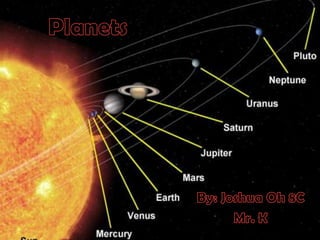
8C Student's Guide to the Planets
- 1. Planets By: Joshua Oh 8C Mr. K
- 2. Mercury Mercury is the closest planet to the Sun. Mercury was photographed by Mariner 10 it photographed 45% of its surface, and it showed us that Mercury had a lot of craters just like our moon. It has cliffs as high as 3 km, it was formed when mercury shrank. Mercury does not have an atmosphere either.So without an atmosphere and since it is so close to the Sun the temperatures can go from 425C to -174C.
- 3. Venus The second nearest to the Sun is Venus. They call Venus “Earth’s twin”, because the size and mass of Venus is around the same as Earth’s. Maat Mons is the highest volcano on Venus, lava flows across hundreds of kilometers. The clouds on Venus are so dense little of the sunlight reaches the surface of Venus. The light that does get through, heats up the surface and gives off heat to the atmosphere, a lot of the heat is absorbed by carbon dioxide in Venus’ atmosphere. So this causes a greenhouse effect like the one on Earth. Since the greenhouse effect is so serious, the temperatures go from 450C to 475C.
- 4. Earth Earth is the third closest planet to the Sun. It is about 150 million km from the Sun. It has water, which can support life. Earth’s atmosphere causes most meteors to burn up in the atmosphere before reaching the surface. It’s ozone layer protects life from the Sun’s radiation.
- 5. Mars The reason why Mars is red, because the iron oxide in the soil give a reddish color. Mariner 9 showed canals most likely carved by flowing water. It also discovered the largest volcano in the solar system, a volcano called Olympus Mons, but it probably extinct. They also discovered large rift valleys. Mars’ atmosphere is thinner than Earth’s, it is made up of mostly carbon dioxide with some nitrogen and argon. The temperatures go from -125C to 35C. Mars has a 25 degree tilt, so that means like Earth it has a seasonal variation.
- 6. Jupiter Callisto Ganymede Europa Io Jupiter is the largest planet in our solor system. It’s atmosphere is mostly made of hydrogen, helium, ammonia, methane, and water vapor. The clouds on Earth are very colorful, it also has continuous storms, such as the “Great Red Spot”. It also has 63 different moons but the biggest four are: Io, Europa, Ganymede, Callisto. Io gets heat up by the gravitational pull that it is known as the most active volcano in our solar system. Europa is mostly made of rock and a thick crust of ice. Under the ice might be a ocean as deep as 50 km. Ganymede is the largest moon in the solar system, it is even larger than Mercury. Callisto is mostly made up off ice and rock, it also has many craters inside it too.
- 7. Saturn Saturn is the second largest planet in the solar system. Saturn’s atmosphere is mostly composed of hydrogen and helium. Much like Jupiter’s atmosphere it also contains ammonia, methane, and water vapor. When you get deeper into the atmosphere the gases become liquid hydrogen and liquid helium. Saturn has several rings, each large ring is made up of thousands of smaller rings. Saturn’s rings are composed of thousands of ice and rock particles. There are around 47 moons orbiting Saturn. The largest moon on Saturn is a moon called Titan, it is larger than Mercury.
- 8. Uranus Uranus is a large planet, it has 27 moons with dark rings. It’s largest moon is Titania, it has many deep valleys and craters. Uranus has 11 rings surrounding it’s equator. The atmosphere there is composed up of hydrogen, helium, and a little methane. Methane give the turquoise color that we see on Uranus. It is blue because the methane absorbs the red and yellow light, and the clouds reflect the green and blue light. Uranus is mostly made up of rocks and ices. It’s axis is very different than other planets, its axis is tiled on the side, some scientists believe that it collided with something which caused it to be tilted like this.
- 9. Neptune Neptune’s atmosphere is composed of hydrogen and helium, with small amounts of methane, just like Uranus.Also like Uranus, the methane gives Neptune its turquoise color. Also like Jupiter it has dark colored storms, one of them is called the Great Dark Spot. Neptune’s surface is mostly composed of rock and different types of ices made from methane and ammonia. Neptune has at least 13 moons, it’s biggest one is called Triton. Neptune has dark rings which are pretty young and won’t last very long either.
- 10. Pluto Pluto is the smallest planet within the other planets, it also is the farthest away from the Sun too. It has a diameter of 2,300 km, it also takes about 248 years for one orbit around the Sun. It has a thin atmosphere, it also has a solid, icy/rocky surface. Pluto has 3 moons: Charon,, Hydra, and Nix.The largest of the 3 is Charon, it has a diameter of 1,200 km and orbits Pluto from 19,500 km away.
- 11. Cites http://www.aerospaceweb.org/question/astronomy/solar-system/solar-system.jpg http://starryskies.com/solar_system/planets.gif http://images.wikia.com/transformers/images/1/1b/Mars.jpg http://upload.wikimedia.org/wikipedia/commons/thumb/7/7d/Mars_atmosphere.jpg/220px-Mars_atmosphere.jpg http://nssdc.gsfc.nasa.gov/image/planetary/jupiter/jupiter_gany.jpg http://www.greatdreams.com/planets/saturn-voyager.jpg http://www.feastoffun.com/topics/science-facts-fiction/2011/01/04/europe-asks-if-it-can-probe-uranus/ http://www.universetoday.com/wp-content/uploads/2010/06/Neptune.jpg http://www.universetoday.com/wp-content/uploads/2010/06/Neptune.jpg